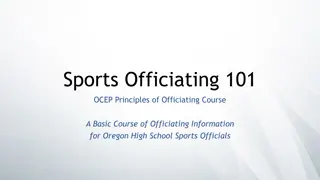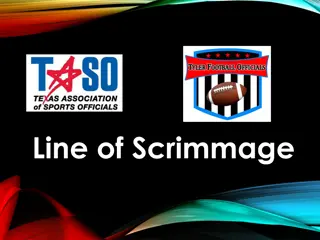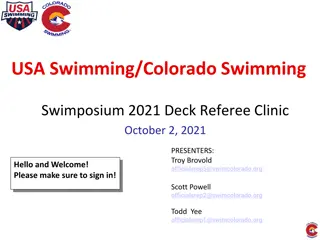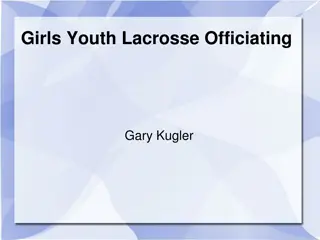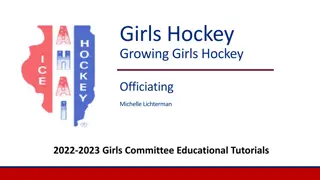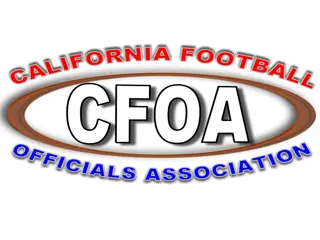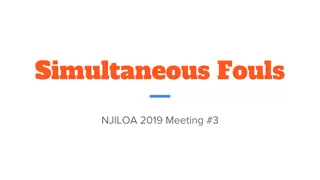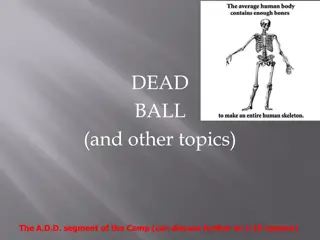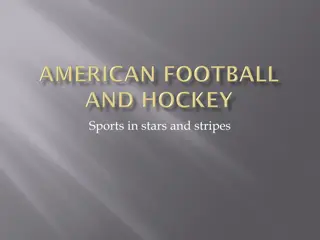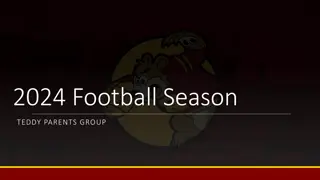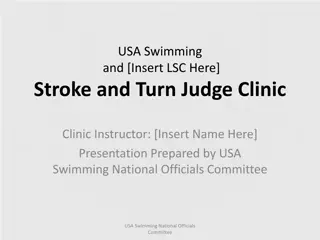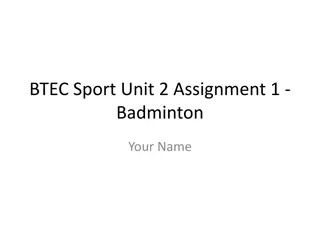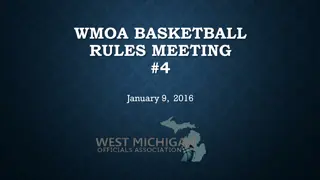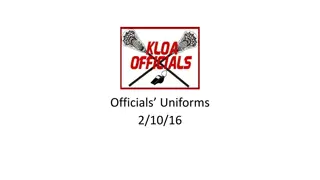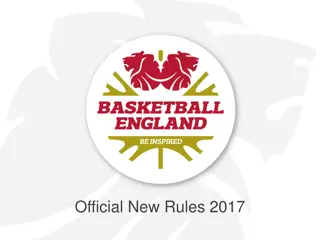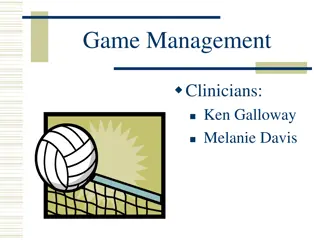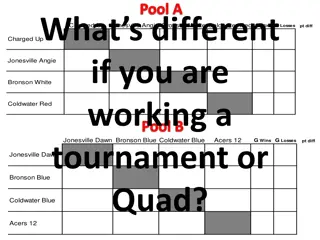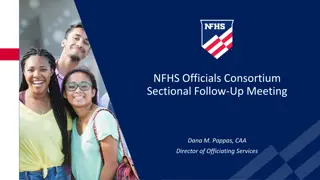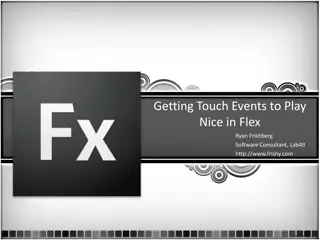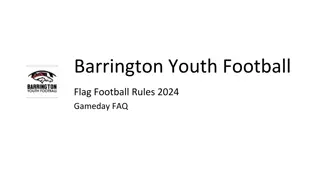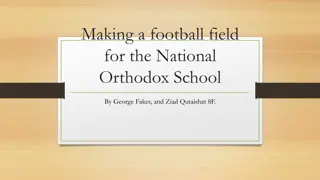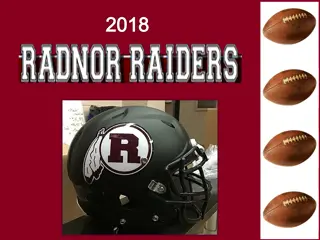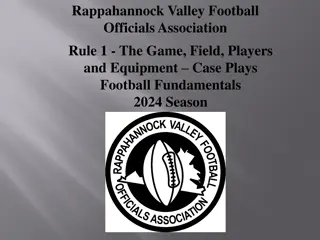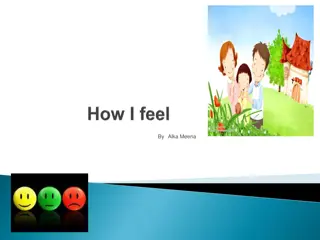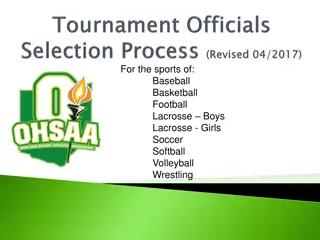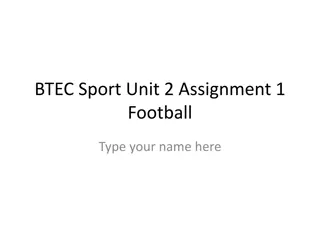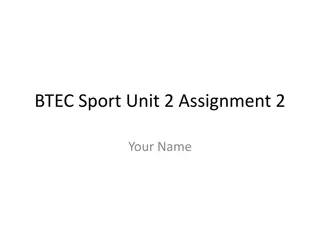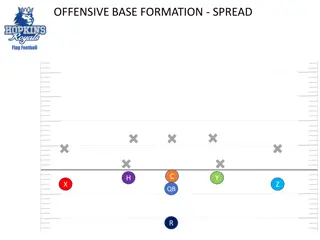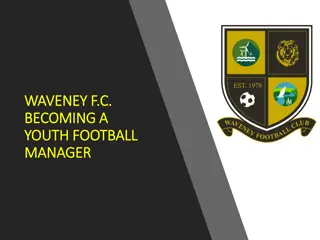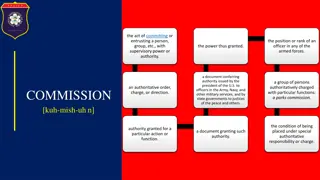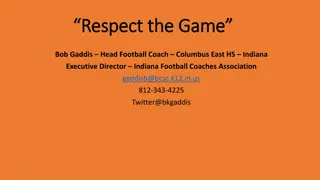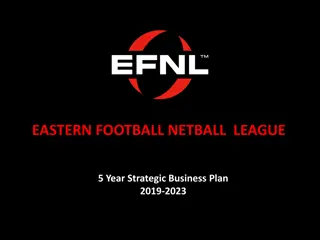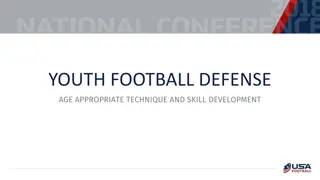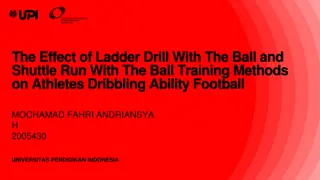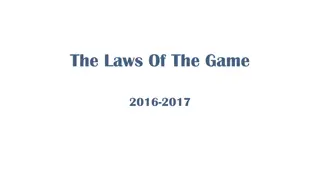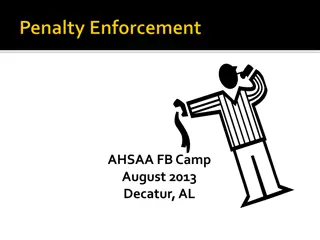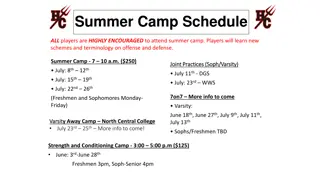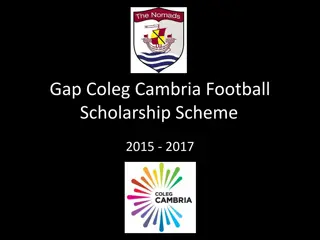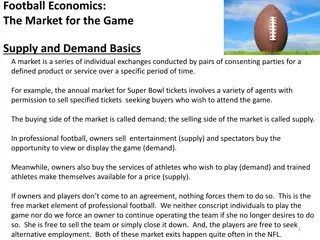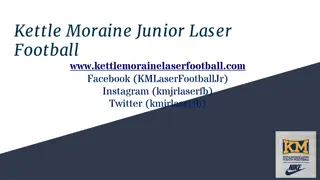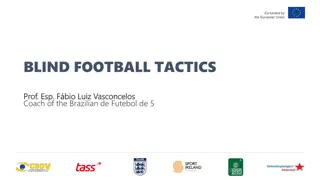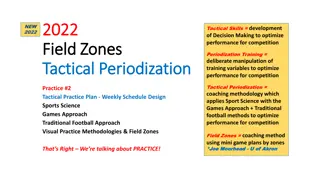Advanced Topics in Touch Football Officiating
This guide delves into advanced touch football officiating topics to help referees enhance their skills and ensure the smooth progress of the game within the rules. It covers diverse areas such as preventing infractions, ensuring player safety, building respect, and maintaining integrity. Key aspects include proper positioning, injury prevention, effective communication, and decision-making based on experience and judgement. The focus is on creating a positive and supportive officiating environment while enforcing rules intelligently and earning player respect through fair and consistent actions.
Download Presentation

Please find below an Image/Link to download the presentation.
The content on the website is provided AS IS for your information and personal use only. It may not be sold, licensed, or shared on other websites without obtaining consent from the author. Download presentation by click this link. If you encounter any issues during the download, it is possible that the publisher has removed the file from their server.
E N D
Presentation Transcript
Touch Football Officiating Advanced Topics Created by Brian Nicholson, Nova Scotia Level III Referee FC Updated April 2013
Outline Aim of Officiating To be a successful referee and crew Positioning Charts for 3 and 4 man crews Special Teams Advanced Topics The Touch, Punting, Penalty Applications Rules Study
Aim of Officiating To cause the game to progress smoothly within the rules Attempt to prevent infractions from occurring Establish subtle, unquestioned influence over the game Be prepared and know your role/job (warm-up&pre-game talk) Be in position React immediately to infractions Active prevention of infractions Warning players of close calls (HL calling offsides) Stopping the game to explain a rule/call
Aim of Officiating Safety of the players is paramount Injury prevention begins with an inspection of the field Preventative/protective officiating Communication and Education Explaining the ruling to the players, benches and fans Providing proper choices to captains on penalty applications Know the psyche of players and temper rulings accordingly Uphold and advance the respect officials enjoy from players, team members and fans.
Successful Officials Enforce rules intelligently Respect the rules, respect the players. Be concerned with the effect of the illegal act; not the act itself. Maintain absolute integrity Be honest, neutral, firm and fair Be confident and supportive of your crew/team Assist don t resist your fellow officials!
Successful Officials Earn the respect of players Find the balance between friendly and aloof Courtesy and respect go both ways Know when to listen and when to ignore Hustle and enthusiasm increase player respect. Understand the mindset of the players Realize that players possess different levels of experience with the game and have different backgrounds, abilities and emotional responses.
Successful Officials Show good judgement Which comes with experience! Attempt to be as consistent as possible Which implies correct rule interpretation to each ruling Have good reaction times Speed=acceptance Show courage to make tough calls in tough situations
Successful Crews Act as a team, not individuals Appear neat (Look sharp-Feel sharp-Be sharp) Recognize limits & errors (and admit them) Know their assignments and positions Provide and accept constructive criticism Are life-long learners Keep up-to-date with the rules Take pride in their work
Positioning Charts: 3 and 4-man crews 3 man crew scenarios Return punts 4 man crew scenarios Introducing the Field Judge Kick-offs, scrimmages, goal line stands, punts
Mechanics of Officiating The 3 basic positions and their responsibilities Referee Back Umpire (BU) or Back Judge Head Linesman (HL)
Mechanics of Officiating All officials have equal jurisdiction in calling penalties. Only the whistle kills the play. Insure that you see the ball and the touch. Penalties that occur during the play do NOT stop the play.
Preparation for Officiating Check your equipment Clean uniform Whistle, bean bags, score pad & pen, watch, cones, flag and field bean-bag marker (optional) Attend the pre-game officials conference Be at the park early enough to set the field for play and inspect the field for any safety issues Be ready to discuss assignments, coverages Try and warm-up to prevent injuries
Pre-game Duties Inspect the Field of play for possible hazards. Eg. Goal posts padded, boundaries marked, etc. Have teams complete scoresheet. 3 minutes prior to kick-off, call for Captains. Introductions, recording captains, coin toss Clarify any rules, check equipment, give warnings regarding jewelry and answer player concerns Record who has first choice in the second half Start the game on time!
Duties of Officials Counting of Downs The referee has the primary responsibility for this with assistance from the headlinesman Use of Whistle The whistle is used to stop the play. It must be blown with authority a loud sharp blast! If you see it, call it. Don t assume.
Duties of Officials Spotting the Ball If you have the exact position of the ball when it goes dead, move to the spot of the tag NEVER take your eyes off the spot. You will not find it again. Once you take the spot, then check to see where the spot is in relation to the bags, lines on the field etc. If you do not have the spot, assist to set up the next play. The HL should take position on the line of scrimmage before the referee or BU moves from the spot. The Referee should bring the bags to the BU or vice versa if there is a sack and the referee has the spot.
Calling penalties If you have a penalty (thrown your flag) and also have to spot the ball, have another official take your place before reporting to the Referee or use your marker or hat to keep the spot. Throwing the flag Try to throw it to where the ball was at the time of the infraction in case the Point Ball Held is required. Know where the ball was and who was in possession when you throw the flag
Reporting Penalties When giving your report to the Referee recall: CINS C-Color of offending team s jersey I- Infraction called N-Number of the offending player S- Stay for more info. ie. Point of infraction, point ball held, possession of the ball
Retrieving the Ball Unlike Tackle football, the players are responsible for getting the ball and bringing it to the LOS. If you do become involved in retrieval, short, underhanded passes should be used to relay the ball to the offense.
Time Outs Time outs can be made by any on-field player to any official. Once the request is made, the referee will then stop the clock and signal time-out . The offense must remain in the huddle until the time out is over. A full minute time-out should be given unless both teams agree to resume play earlier. Inform the players and benches when 15 seconds are remaining.
Quarter Time When changing ends, ensure you know the down and the distance to gain a first down before moving the bags. By using the nearest line on the field the Referee will pace off and measure the distance of the line of scrimmage from the nearest line. The other bags shall be placed correctly accordingly.
Half Time Be sure to remain away from the teams so you can discuss the first-half performance and make adjustments in the second half. 3 minutes prior to the end of half time, the officials will meet with team captains to confirm the score and obtain the choices from the captains to begin the half.
End of Game Remove the cones and bean bags from the field immediately (usually done by the BU and HL). Scoresheet The referee should sign the game scoresheet after checking the scorecard. The referee should also record any ejections or objectionable conducts on the sheet.
Post-game Discussion Be prepared to offer constructive criticism to other officials about their views. Accept criticism as you would deliver it. Complaints If you feel a complaint is justified against a player, coach, team member or game conditions were unsatisfactory, these should be made in writing to the President of the League or the President of the Officals Association.
Last minute comments Prior to start of game Everyone got their flags and whistles? Does the anyone have the bean bags? If we make a mistake, we make it hustling!
G 10 20 BU O O O O R 30 LoS O O HL C X X X X X 40 QB R
the officials triangle G 10 BU 20 O O O O R 30 LoS O O HL C X X X X X 40 QB R
BU Duties on Scrimmage Play Set bean bags Count defensive players Look for remote zone interference / rough play Look for pass interference Watch for tags and rough tags After whistle: Reset bags if appropriate G 10 BU 20 O O O O R 30 O O C HL LoS X X X X X 40 QB R
Back Umpires Special Duties Punts Position yourself 5-10 yards away from but parallel to the return player Be alert for laterals Make a no-yards call if applicable Watch for return punts from the end zone. Rouge and Safety Touch Determine the ball position when the ball went dead. Goal Line Plays Goal posts: watch for Ball hitting Players using to advantage
G 10 20 BU O O O O R 30 LoS O O HL C X X X X X 40 QB R
HL Duties on Scrimmage Play Repeat/confirm down with Referee Watch for offsides Watch Rusher for lining up offside Move at least as far as 1st down bag or move downfield with play, watching for infractions and spot of ball HL position G 10 BU 20 O O O O R 30 O O LoS 40 C HL X X X X X QB R
Special Situations for HL Punts Hold the LoS until you are certain that the ball will cross the LoS, in flight. If the punt is good, hustle downfield and get parallel to the ball carrier, and follow them. Call no yards where applicable Goal Line Plays Goal Line becomes 1 responsibility When the ball is snapped, move downfield but hold at the Goal Line. You must determine the forward point of the ball when the player is tagged. If it breaks the plane of the goal touchdown! The above applies on convert attempts.
BU & HL coverage areas and position G 10 BU 20 O O O O R 30 LoS O O HL C X X X X X 40 QB R
Referees coverage area G 10 BU 20 O O O O R 30 LoS O O HL C X X X X X 40 QB R
R Duties on Scrimmage Play Count offensive players Announce down Whistle the play in/start 20 second play clock Indicate when 5 seconds are left on 20 second play clock Watch for interference on rush Note side R is on & watch for double rush Watch for interference on rush or remote zone interference on center Watch for QB tags and rough tags Signal direction of pass (on or offside) If QB scrambles and throws note point of release (was he over the LoS?) After whistle: Give bags to BU if appropriate G 10 BU 20 O O O O R 30 O O C HL LoS 40 X X X X X QB R
Referees Special Scrimmage Duties Goal Line Plays Confirm coverage with other officials Check with other officials before signaling touchdown defense and benches of decision Converts Safety Touch Asking the offensive captain what type (1 or 2 point) they are attempting Informing the Make sure the ball is still in the end zone. Signal Safety Touch BE SURE TO STOP CLOCK Inform captains of choices for the next play
Referees Duties Calling Penalties If there is a flag, wait for the official to come to you to report the infraction Check for multiple flags Inform captain of non-offending team of the infraction and available options. Signal the benches (Team, Number, Infraction, Accepted/Declined)
Kick off set up G BU O O 10 O 20 O O 30 O O 40 HL 50 C R K X X X X X X
R moves downfield after determining there has been no offsides. Call tags & rough play HL moves downfield after determining the kick has travelled 20 yards, keeping outside the widest player on the receiving team. Call tags & rough play BU moves behind ball carrier to watch for touch. Signals onside or offside pass. WATCH for ROUGH PLAY! G BU O O 10 O 20 O O 30 O O 40 HL 50 C R K X X X X X X
PUNTS Referee Duties Position yourself with the punter Cover the sideline opposite the HL In short punts be prepared to move up to cover the punt return and rule on no yards BU O G Back Umpire Duties Position yourself parallel to the return player Rule on No Yards Rule on the direction of muffs Follow behind ball carrier looking for tags & ruling on direction of pass 10 20 O O O R 30 LoS O O Head Linesman Duties Stay on the LoS until the punted ball crosses the LoS. Move downfield to get parallel to the ball carrier. Assist the BU on No Yards and ruling on laterals. HL C X X X X X 40 P R
Return Punts P Back Umpire Duties Position yourself with the punter Watch for roughing the punter Prepare for another punt BU O X X O O G Head Linesman Duties Position yourself on the goal line (if applicable) and rule on whether the ball has left the end zone. HL X O X O X O 10 X 20 Referee Duties Establish the No Yards Zone around the new returner. Prepare for another punt. R 30 R 40
Four Man Crew introducing the Field Judge G 10 BU 20 O O FJ O O R 30 LoS O O HL C X X X X X 40 QB R
BU, FJ & HL coverage areas and position G 10 BU 20 O O FJ O O R 30 LoS O O HL C X X X X X 40 QB R
Field Judge Scrimmage Duties BU, FJ & HL coverage areas and position Line up parallel to rusher and outside the widest receiver On the snap, move downfield, covering the outside two receivers. Cover the sideline G With the FJ present, the HLcan hold the LoS until the rusher crosses the LoS. 10 BU On goal line stands line up on the goal line and 5 yards outside the widest receiver. Hold this position. This allows the HL to stay on the LoS. 20 O O FJ O O R 30 O O C LoS HL On a punt, move downfield and go parallel to watch for tags and lateral passes and to cover the sidelines. X X X X X 40 QB R
The Touch the little understood fundamental 1. A touch must be deliberately intended. If the defender plays the ball and, while swiping at the ball, accidently touches the opponent - no touch. Touching any part of the player is a touch This includes: skin, the ball, clothing, or extras, such as a towel, a bracelet, or even an unraveling shoestring Using the word "hand" in the rule is intended to mean the open hand and / or fingers. The back of the hand, not just the palm side, is included in this definition. This allows a fist to be considered a touch. If an official clearly sees a finger-tip touch, no matter how slight the contact, the touch ,must be called. 2. 3. 4. If the hand is not used - no touch.
The Touch the little understood fundamental 5. When a defender deliberately avoids a collision by jumping over the ball carrier, we must award a touch. 6. The bobbled ball routine must be called a touch. 7. When a player kneels down to concede points, a touch should be awarded. e.g. a quarterback kneels down to concede a play Do not confuse loss of balance with a kneel to concede As for the fallen ball carrier, if the player hesitates to get up, one can assume there is no intent to advance further.
Punting all you wanted to know and more! No Yards Punt vs. Whiff vs. Dribbled ball Possession after a punt Deflected Punts Blocked Punts Return Punts Muffed Punts
PuntsThe No Yards Rule After a punt, players of the punting team cannot touch the ball or be touched by the ball before the opponents touch the ball. After a punt, all players of the punting team must be 5 yards away from the ball when an opponent first touches the ball. Violation of this rule is a no-yards penalty . If the offending player affects the play, it is a 10 yard, while a 5 yard no-yards is for the player who did not affect the play Bad luck and poor awareness of the ball do not negate this penalty!
Punts Definition A punt is a ball that is dropped from the hand and kicked with any part of the body below the knee before the ball touches the ground. Anyone may punt the ball, at any time, with the exception being on a convert play or using a punt to replace a kick-off. A dribbled ball is like a punt except the player striking the ball does not have control of it. The ball remains live until it hits the ground and is considered as either an onside or offside pass depending on its direction.
Punts (placement of Dribbled Ball) After the ball is ruled dead , the ball will be placed at 1 of the 3 following spots, whichever is closest to the dead line of the dribbling team. Where the ball was first kicked Where the dribbling team touched the ball last Where the ball touched the ground If the non-dribbling team touches the ball before it becomes dead, the ball will be placed at either of the first two above options, whichever is closer to the dead line of the dribbling team.
Possession after a Punt Possession changes immediately after a punt, unless the punt is blocked, or is considered to have never left the end zone. (Rule 19.3.1)


